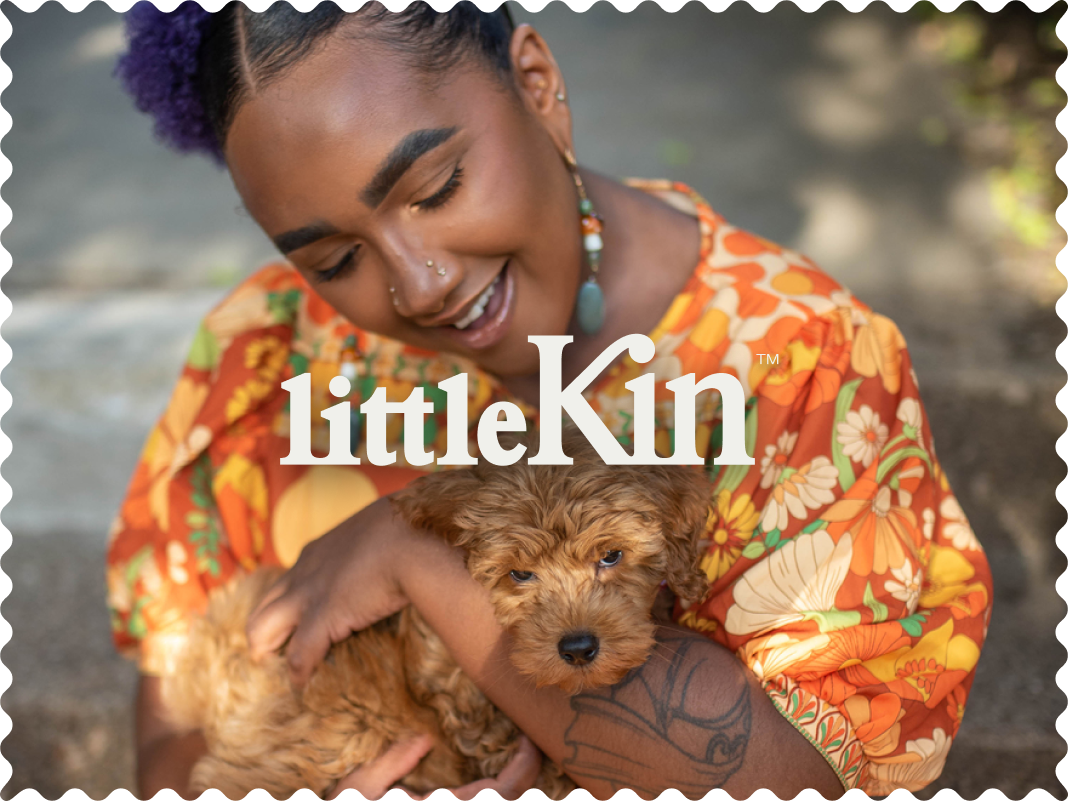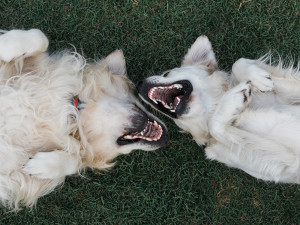Why Do My Dogs Teeth Chatter?
It’s not always a sign of being cold...
Ever been intrigued by dog teeth chattering? Wondering if it shows – like for us – that your dog is cold or nervous? This interesting part of dog body language can actually be linked to a range of causes – including one really interesting one: scent processing. From pain, to stress, illness or analysing smells, let’s explore why do dogs chatter their teeth, when it’s harmless and when it might signal that there’s something more serious going on.
What is dog teeth chattering?
Dog teeth chattering (or dog jaw chattering) refers to a repetitive vibrating movement of a dog’s mouth. It can resemble shivering that centres around the jaw area – similar in look to when a human might be chattering their teeth. This behaviour can happen for a brief moment or you may see it occur for a few minutes at a time.
When observing dog body language we regularly see mouth-related behaviours like yawning, licking or panting – but this chattering behaviour isn’t seen in all dogs or might be a less frequent occurrence. When the chattering is related to illness or pain, it’s likely to be an involuntary action – not directed at an object or activity. Whereas when we see aggressive jaw snapping, anxious lip licking, or playful mouthing then it’s usually when a dog is in a specific environmental context.
In most cases, occasional chattering is harmless and simply reflects a dog’s reaction to stimuli like cold, excitement or intriguing smells. However, frequent or persistent episodes could indicate an underlying issue such as dental pain, anxiety or even neurological problems. If you start to see your dog chattering their jaw more regularly than normal, or it becomes paired with other unusual symptoms, it’s definitely worth a visit to your vet.
The 6 main reasons dogs chatter their teeth
There are a number of reasons why you might see your dog chattering their teeth – from pain to illness, cold and scenting.
1. Scent processing and the flehmen response
One of the most interesting reasons for dogs chattering their teeth is for scent processing through the dog Flehmen response. While you probably already know that a dog’s nose is pretty unique, you might not be aware that they also have a very special part of their body that helps them to analyse complex scents. The vomeronasal organ (VNO), or Jacobson’s organ, is a sensory structure that detects pheromones and other chemical cues. Separate from the main olfactory (scent) system, it influences behaviours like mating, social interaction and predator detection.
When a dog encounters an especially intriguing scent, such as another dog’s pee, female pheromones or certain chemical smells, they may curl their lips and chatter their teeth to help draw scent particles into this specialised olfactory organ in the nasal cavity just above the roof of the mouth. This behaviour is typically short-lived and accompanied by sniffing or lip-licking.
While this type of dog scent processing is normal and often seen in both male and female dogs, it’s more commonly seen in unneutered male dogs – chattering their teeth over an area of grass after a female has toileted there. As long as the chattering is situational – not excessive or compulsive – it’s generally nothing to worry about. It’s just your dog’s way of exploring their environment more deeply.
2. Excitement and anticipation
When we think of dog excitement behaviour, we would commonly be thinking of body language cues like wagging tails, alert posture or play invitation bows. But teeth chattering can be another dog anticipation sign. You might see your dog chattering their jaws when they anticipate something they love, like playtime with a favoured dog or human, the arrival of their food bowl, or your return home.
This type of chattering is usually accompanied by a relaxed, happy body language: loose body, bouncy movements, relaxed posture, wide wagging tails and a lolling tongue. It might be more common in excitable dogs or those that are highly attached to their humans.
While this sort of excited behaviour from your dog might be normal, if the chattering becomes obsessive or is shown in combination with other stress signals like pacing or whining, it may indicate that your dog is in an overstimulated or anxious state. In this case, you might want to look at how you can help them to feel more relaxed – adding in more calming activities and seeking the support of an ethical dog behaviourist.
3. Cold weather response
Dog cold weather behaviour is probably one of the more anthropomorphic body language cues we can easily recognise. We know as humans that the cold can make us shiver – and dog shivering is no different, with full body muscle tremors sometimes accompanied by teeth chattering.
Young puppies, senior dogs and those with much thinner coats or low body-fat scores are more prone to chattering due to their lower level of natural insulation. We are very used to looking out for warmer temperatures to protect our dog’s health – but cold temperatures can also be dangerous for their well-being. Usually, temperatures below 7C will start to trigger these colder responses in sensitive or slender breeds. Dogs who are unwell are also more susceptible to the cold.
If your dog’s teeth begin chattering outdoors and the temperature has dropped, it may be time to bring them inside or provide them with a dog coat or blanket. Keeping your dog warm and limiting exposure in cold weather is important when trying to prevent cold-induced chattering.
4. Dental pain and oral issues
One of the most common times that your vet will need to see your dog – especially if they suddenly start chattering their teeth frequently – is for dog dental pain or other oral health issues. Dogs may chatter their teeth in response to discomfort, inflammation or even neurological stimulation triggered by problems in the mouth. This chattering is often an involuntary reaction to pain or pressure, particularly in sensitive areas such as the teeth, gums or jaw.
Common causes of dog tooth pain include broken or fractured teeth, gingivitis, periodontal disease, oral abscesses or infections below the gum line. These conditions can all lead to significant discomfort, prompting your dog to chatter their teeth or jaw. In fact, my own dog used to visibly judder his jaw when trying to yawn, which we later discovered was due to temporomandibular joint (TMJ) dysplasia – a malformation of the jaw joint that can be painful and affect a dog’s ability to chew, yawn or even play normally.
In addition to jaw chattering, signs of oral discomfort may include persistent bad breath, excessive drooling, bleeding from the mouth, reluctance to eat harder foods, or pawing at the mouth or face. You might also notice changes in behaviour, such as irritability or anxiety, if your dog is dealing with ongoing pain.
If dental problems are suspected, a visit to your vet is essential. Left untreated, oral issues can lead to infection or chronic pain. Your vet may recommend dental X-rays, professional cleanings, or even tooth extractions depending on the underlying problem. Regular dental exams and preventive cleanings can significantly reduce the risk of oral health complications.
5. Anxiety and stress response
There are many dog anxiety symptoms, including – among others – poor sleep, increased reactivity, fearfulness in specific situations, and even a sudden refusal to eat. These behaviours may seem subtle at first, but they often point to a deeper emotional struggle. One lesser-known but significant physical manifestation of dog stress is teeth chattering. Just as humans may clench their jaws or grind their teeth when anxious, dogs might exhibit similar behaviours by rapidly chattering their teeth in response to heightened stress or fear.
Triggers for this stress response can vary from dog to dog, but common culprits include loud or sudden noises, unfamiliar environments, separation from their guardians, or even small changes in their daily routine. During such episodes, you might also notice your dog pacing, panting, trembling or attempting to hide. Jaw juddering or chattering may appear at these moments, reflecting either emotional distress or potentially underlying physical pain. A scared dog may also be trying to gain extra scent information by engaging the vomeronasal organ to try and better understand their environment, or the dogs within it.
Pain and stress often go hand in hand – if a dog is physically uncomfortable, it may feel more vulnerable, which amplifies its anxiety. To help an anxious dog, it’s essential to identify and understand the underlying cause of their distress. Providing a calm, safe space and maintaining consistent routines can offer some comfort. For dogs with more severe anxiety, the use of calming supplements, combined with guidance from your vet and an ethical canine behaviourist, may be necessary for long-term support and well-being.
6. Neurological conditions
While more rare, dog neurological symptoms can include jaw chattering. Conditions like epilepsy, tremor syndromes or even brain inflammation may cause your dog to chatter their teeth.
Other kinds of common dog seizure signs include: loss of coordination, stiffening of muscles, jerking movements, drooling or foaming at the mouth, collapse or even loss of consciousness. Your dog may also lose control of their bladder and/or bowels. They may appear disorientated following the seizure or even act aggressively. Watching for early warning signs such as twitching or loss of coordination, alongside potentially teeth chattering, is important.
If your dog’s jaw judders are paired with any of these neurological signs, it’s important to treat this as an emergency. Seek out the support of your vet immediately and ensure a full evaluation is conducted so you can get a proper diagnosis. Your vet may need to complete blood tests or run diagnostic MRI or CT scans. With the right diagnosis and treatment – such as medication – many dogs can continue to live normal, healthy lives with reduced neurological symptoms.
When to worry: red flags to watch for
Teeth chattering that occurs in your dog frequently and without clear triggers – like the cold or sniffing another dog’s pee – may indicate a health problem. Jaw chattering accompanied by other signs of pain or neurological changes should never be ignored as it may be a dog teeth chattering emergency.
If you suspect your dog is unwell, make sure you pay close attention to any accompanying symptoms. Red flags, to be especially mindful of, include excessive drooling, bleeding from the mouth, refusal to eat, changes in behaviour or balance/co-ordination issues. Keep your vet’s emergency contact details somewhere prominent in your home, so if you have any concerns, you can call them immediately.
Monitoring patterns of behaviour can be helpful in any dog veterinary emergency. Note down how often you see any of the worrying behaviours or symptoms happening, the context they occur in, and any other relevant information. This information will be valuable for your vet to assess whether the behaviour is part of a more serious issue or not.
While teeth chattering may be a normal part of dog behaviour, especially when it comes to responses to the cold or engaging in scent processing activities, it doesn’t mean that we should ignore changes in the frequency your dog does the jaw motions or the context they occur in. It could well indicate that your dog is unwell, in pain or struggling with life emotionally.
How to help your chattering dog
If you’re wondering how to help dog teeth chattering it’s important to start by identifying the underlying cause – it may be something requiring medical support or may be a natural, normal response to the situation and need no intervention at all.
For non-serious cases like excitement or cold, you can offer comfort to stop dog teeth chattering by bringing your dog indoors, giving them a blanket or coat to warm them, or providing calm support. If the chattering is linked to excitement, engaging your dog in calming activities, encouraging appropriate behaviour, and trying to avoid stimulating situations may be the key to reducing the chattering. Adjusting the environment your dog is in – by offering calm spaces to relax and blocking out the stimulus of the world – can make a big difference.
For dogs with dental discomfort, a vet consultation and simple dental care may resolve the issue quickly. But if your dog has a more complex medical need – such as a neurological concern – then there may be some more in-depth medical investigations needed. Never play the ‘wait and see’ card when it comes to your dog’s health – while it may be nothing, early intervention is always going to be better in the recovery process.
Observation is key. Only intervene if the teeth chattering is persistent, appears painful, or worrying for your dog. Otherwise, it’s often best to let your dog express themselves naturally.
It may be as simple as your dog processing scent as part of their natural way to engage with – and understand – the world around them.
Prevention and management strategies
To prevent dog teeth chattering and improve overall well-being, consider proactive strategies. Regular vet checkups, especially dental exams, are essential to rule out medical causes.
Dog behaviour management and addressing your home environment, such as keeping your dog warm and reducing stressors, are also effective strategies. Take your time, introducing your dog gradually to new situations and maintain a predictable routine.
Training techniques such as desensitisation and positive reinforcement help dogs develop better coping mechanisms. Remember that teeth chattering can be a normal part of dog body language, especially when it comes to scent processing – but by staying observant and responsive, you can reduce the frequency of jaw chattering and ensure your dog stays happy and healthy.




